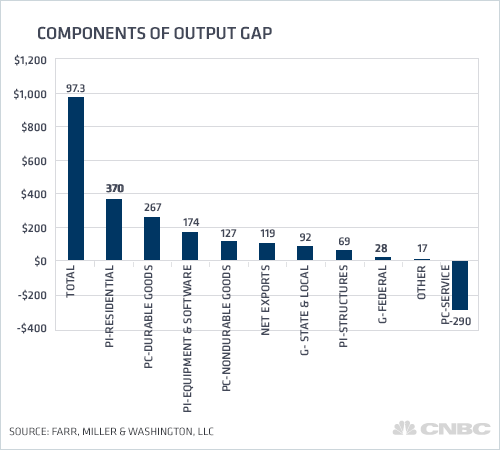There was an interesting article in The Washington Post yesterday by Neil Irwin entitled "What Exactly is Dragging Down U.S. Economy". In this article, Irwin analyzes the output gap, which is defined as "the difference between what the U.S. economy is capable of producing and what it is actually producing."
This difference arises because the economy is operating at less than full employment and factories are not being fully utilized.
Irwin suggests that if the economy were operating at full capacity, economic activity would be higher by $973 billion compared to current levels. This $973 shortfall relative to potential represents over 6% of expected GDP for 2012.
Irwin then goes on to break down the components of the $973 billion output gap.
To do this, he uses data from 1985 to 2005 to determine the average contribution from each sector of the economy to overall economic output. He then uses those averages to determine how much would be produced by each sector of the economy in a world of full employment and normal factory utilization. And finally, he compares those theoretical values to the actual current levels of production by each sector of the economy. Using this method, Irwin is able to give us an idea as to which sectors of the economy are most responsible for our current GDP shortfall relative to potential.
The conclusions to Irwin's analysis are summarized in the chart below, and they should not be overly surprising to anyone.
The two biggest contributors to the output gap are residential investment and consumer spending on durable goods (goods last more than three years). The shortfall from these two sectors combined comes to $637 billion, or 65% of the total output gap.
The reasons for the weakness in these sectors are fairly obvious. During the past few years, we witnessed the bursting of twin bubbles in housing and credit. Plummeting housing prices and reduced access to consumer credit has led to lower spending on residential investment and more expensive consumer items (which generally are bought using credit). At the same time, consumers remain fearful of job loss and stagnant incomes, causing them to spend less freely than in the past. Despite aggressive monetary policy by the Fed, we have not been able to break out of this vicious cycle for several years.




